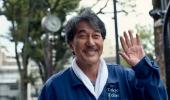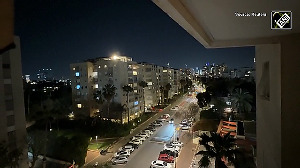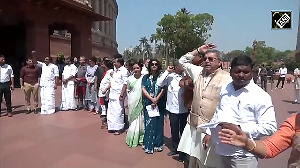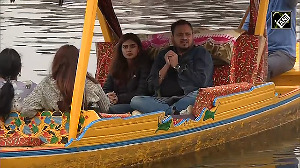Tokyo -- the songs Japan, Love In Tokyo and Sayonara from the 1966 Hindi film automatically pop up in the mind -- is buzzing and crowded like any other metropolis, discovers Deepa Gahlot.
The modern apartment blocks are built cheek by jowl, so close together that one can open the window and borrow sugar from the neighbour in the next building.
One of the fears of the Indian traveller is the unavailability of vegetarian food.
Every city and town in Japan has an array of Indian restaurants that serve every variety of cuisine, right from Gujarati to Punjabi to Andhra and Kerala meals.

After my first trip to Japan, this sci-fi thought comes to mind: There must be subterranean armies of workers in Japan, who emerge when nobody's looking, to make sure the pretty flowering plant arrangements on the streets are trimmed and watered, the currency exchange machines always filled with coins and notes, snacks and beverages are stocked limitlessly in those fabulous vending machines and the hands-free toilets spotlessly clean!

Even the manhole covers are artistic, like this one in the pic above.

The streets are trash free, and not a bin in sight, because right from childhood the Japanese have inculcated the habit of carrying bags in which to place their wrappers and takeaway cups and dispose of them at home or in public restrooms. Just like they are taught as kids, to wait at the pedestrian crossing till the light turns green -- even if there is no traffic. And to eat with chopsticks.
This discipline ensures that the trains run on time. If the bullet train is a minute late due to some emergency, announcements are made and a chyron strip runs with an apology for the delay!
Everybody gets into orderly queues, whether it is to buy tickets or wait for service at the dozens of 24-hour provision shops, dotting every street.

Pictures of Japan already swirl in the head through films of Akira Kurosawa, Nagisa Oshima, Yasujiro Ozu, and the books of Haruki Murakami, Yukio Mishima and Keigo Higashino.
Images of men and women in kimonos, moving with a gentle rhythmic grace, and also modern Japan of tech innovations, Yakuza gangsters, Fujifilm, anime and manga comics.
The tiny country is associated with cherry blossoms, samurai, ninjas, judo, bonsai, kabuki, geishas, the tea ceremony, origami, karaoke, Godzilla, Hello Kitty, Pachinko, sake, tatami mats, rice paper, calligraphy, capsule hotels, kamikaze attacks, hara-kiri, ikigai, kaizen, Nintendo, robot baristas and earthquakes; also the horrors of nuclear warfare, with Hiroshima and Nagasaki being the targets of an atomic bomb.
For all its preservation of Buddhist and Shinto shrines, the Japan we see is almost aggressively modern -- there are multi-layered flyovers for cars, that look nearly futuristic, like the toilets with their rows of buttons for washing, drying and deodorising functions; and the vending machines are works of art.
If you want, say, coffee, there is a choice of strong, medium or light beans, with or without milk and sugar; you put the coins in, watch the coffee being brewed on a screen and, after a few minutes, the takeaway glass with cover descends into the pick-up slot.
People wear smart Western clothes -- no kimono sightings -- and the women are immaculately turned out in trendy outfits and subtly made-up, with luminous skin and glossy hair.

Osaka is the start of the journey -- in large parts a bleak-looking industrial town, rendered even more grey by the rain, that stopped the cherry trees from blooming. There are also green areas with traditional architecture and many well-maintained shrines.
But first a visit to the Kobe Earthquake Memorial Museum at Kobe, 33 km from Osaka. It's an attractively beautifully designed and curated space documenting the Great Hanshin Awaji earthquake that completely destroyed the city of Kobe when it hit on January 17, 1995.
The museum opened in 2002 to commemorate the tragedy. Along with documentaries and dramatic recreation of the disaster, there are videos of people who survived. More than the destruction, the museum tells the story of a quick and courageous reconstruction of the city.
The resilience of the Japanese people is better proved by how Hiroshima came up from the rubble of the atomic bomb, but before the pilgrimage to the site of a monumental man-made calamity, there's Nara Deer Park and the stunning Todai-ji Temple, at Nara, to explore.

The deer walk around the park, posing for pictures with tourists, not in the least intimidated by crowds.

The deer park encircles Todai-ji Temple, an imposing Buddhist place of worship in Nara, that is considered one of the most powerful of the Seven Great Temples of Nara.
Its Great Buddha Hall houses the world's largest bronze statue of the Buddha, and has been listed as a UNESCO World Heritage Site and one of the eight Historical Monuments of Ancient Nara.

Inside the temple are murtis of the Buddha in various forms. Outside, there is an unusual cadaverous statue, covered in a red hood -- the Binzuru Pindola, one of the original followers of Buddha.
It is believed that he has the powers to heal ailments, and worshippers rub the part of the idol's body corresponding to the part on their own body that needs healing.
For all their progress, the Japanese, like us Indians, are superstitious. The temples sell good luck charms in the shops attached, along with other souvenirs.

Many of the other historical and religious sites around here have been rebuilt over a period of time and have a fascinating history with monks, samurai, shoguns, emperors and monks, too complicated to understand easily.
Like the magnificent Osaka Castle, a striking structure from the outside and a museum inside, with each floor offering different exhibits about Japanese history.
Every year, there are forecasts about when the sakura (cherry blossoms) will bloom, and on the night before, people gather in the sprawling gardens of the castle, with their picnic baskets to celebrate the event.
From the historical to the contemporary -- Osaka's bright Shinsaibashi-Suji street area has everything for shoppers, from branded stores to street stalls for fashion accessories and household goods, most of them with that ubiquitous Made in China tag.
The next day is an adventurous one for us -- riding the bullet train from Shin-Osaka to Hiroshima.
The train is spanking clean and comfortable, with plenty of leg room and as it zooms through the countryside, there are views of villages, fields, hillocks, forests and industrial complexes.
It is a bit like travelling by the Rajdhani, but maybe faster.

Reaching the Hiroshima Peace Park and looking at the A-Bomb Dome, the skeletal ruin of the former Hiroshima Prefectural Industrial Promotion Hall, evokes complex emotions of horror and anger at how innocents going about their lives were massacred when the Americans dropped the first atomic bomb.
The building was closest to the hypocentre of the bomb and was left partially standing. It has been left as it is, as a memorial to the casualties of war. The A-Bomb Dome was added to the UNESCO World Heritage Site List.

Within the large complex, there is also the Children's Peace Monument, a statue dedicated to the kids who lost their lives in the bombing.
The statue shows a girl holding an origami paper crane in her outstretched hand. She represents Sadako Sasaki, a little girl who, before she died of radiation from the bomb, set out to fold 1,000 paper cranes. Other children took over from her and there are thousands of colourful paper cranes placed near the monument.
The museum built in the park has a lot of information and exhibits from that dreadful moment in Japan's history.
Hiroshima is today a busy, bustling city, but the pall of that day -- August 6, 1945 -- still hangs in the air.
This city, and Nagasaki a few miles away, are reminders of why nuclear weapons should never be unleashed upon the world.

After the distress of Hiroshima, is the calm serenity of the Itsukushima shrine on Miyajima Island, reached by a ferry ride.
The Shinto shrine is designated a National Treasure and also a World Heritage Site and is best known for its floating torii gate, which, when the tide is in, looks like it is submerged in water.
The torii gates at this island have come to become a symbol of Japan seen on tourist posters along with the pink sakura (cherry blossoms) and Mount Fuji.
This traditional structure, painted vermillion or deep orange, marks the entrance of a Shinto shrine, where worshippers enter a sacred space, leaving the regular world behind.
The Japanese guide explains that the Shinto religion believes that supernatural entities, called kami, exist in all things -- so quite like Hinduism, Shinto believers worship nature, and even inanimate objects. Shrines could be anywhere, even in the kitchen of a household.

The next stop is Kyoto and the beautiful Kinkaku-ji Golden Temple, covered with gold leaf, surrounded by meticulously landscaped gardens, and then on to the Toyota Kaikan Museum, where a dazzling array of cars is on display.
Along with electronic giants like Sony, Panasonic, Toshiba and Hitachi, Japan's car manufacturers include among others, Toyota, Honda, Nissan, Mitsubishi, and of course, Suzuki.
Japanese-made cars, constantly innovating, gave tough competition to the American and European automobile industries.
In cities, however, like everywhere else, parking is expensive, so many commuters prefer the faster metro train to go to work.

There's one more exciting spot to visit, before Mount Fuji. A cable car from Hakone takes the visitor to Owakudani, the area around a crater created during the last eruption of Mount Hakone 3,000 years ago.
It remains an active volcanic zone, and is famous for sulphurous fumes and hot springs, that are supposed to cure many ailments.

It is also believed that eggs cooked in Owakudani's hot springs have black shells, and eating one can prolong life by seven years!

After days of wet and cold weather, the sun briefly comes out, so that majestic Mount Fuji shimmers in all its glory.

Because of snowfall the previous day, tourists are permitted only up to the second level, but that doesn't detract from the inverted ice-cream cone beauty of the mountain, and a walk around the villages and shops in the area is wonderful, surrounded by picture postcard cottages, small streams, breathing fresh, clean air.

The hunt for cherry blossoms goes on, and when another group of travellers reports a tree blooming in the Shinjuku Gyoen Garden, the vote is to veer from the itinerary and go there.
A solitary tree is in full bloom and the crowds go crazy taking photos with it.

The city of Tokyo -- the songs Japan, Love In Tokyo and Sayonara from the 1966 Hindi film automatically pop up in the mind -- is buzzing and crowded like any other metropolis.
The modern apartment blocks are built cheek by jowl, so close together that one can open the window and borrow sugar from the neighbour in the next building.
The business areas have gleaming glass towers, and tucked in between are gardens, temples and shrines.

Tokyo Skytree, breaks global tower records standing 634 metres, and from the 360-degree observation deck at the top, the entire city is laid out, looking like a miniature zone.
One of the lower floors has a glass floor, from which one can see right down.

Travellers from Mumbai are amused that the Shibuya Crossing is a tourist attraction, the spot from where thousands of pedestrians cross the junction when the lights go green.
At Churchgate Station at peak hour, there's a similar sight -- only the layout at Shibuya is more complicated.
Also found here is the statue of a dog, Hachiko, a faithful animal that waited every day at Shibuya Station for ten years, for his master, who had passed away.
Hachiko is an unofficial mascot of Shibuya and the statue a popular landmark and meeting point.

The infrastructure of broad streets and flyovers is enviable.
The authorities have prepared for floods by building several underground water reservoirs beneath Tokyo to protect the city and its surrounding areas from flooding.
The main reservoir of the Kasukabe flood tank, north of Tokyo, called G-Cans by residents, is the largest facility of its kind in the world.
The underground reservoirs also make sure the city's water supply does not run out, with groundwater regularly replenished.

One can't leave Tokyo without a stroll around Ginza, one of the most expensive shopping districts in the world, with its row of outlets of upscale international luxury brands, as well as boutiques, restaurants and coffee shops.

One of the fears of the Indian traveller is the unavailability of vegetarian food.
Every city and town in Japan has an array of Indian restaurants that serve every variety of cuisine, right from Gujarati to Punjabi to Andhra and Kerala meals.
Delicately-flavoured Japanese food is still an acquired taste for the Indian palate.

Needless to say, a week is not enough to explore even one city in this wonderful country, but it serves as an overview of contemporary Japan racing ahead in the technological and economical fields, but, like any ancient civilisation, trying to preserve its history and heritage.
Cherry blossoms are in many other countries too, but it is still the Japanese sakura that is every traveller's dream -- walking through a forest of candy flower pink and inhaling its mild, sweet scent. We didn't see forests, but we thank that one tree for blooming on demand for us, so our trip could be a complete Japan experience.
Feature Presentation: Ashish Narsale/Rediff.com











 © 2025
© 2025